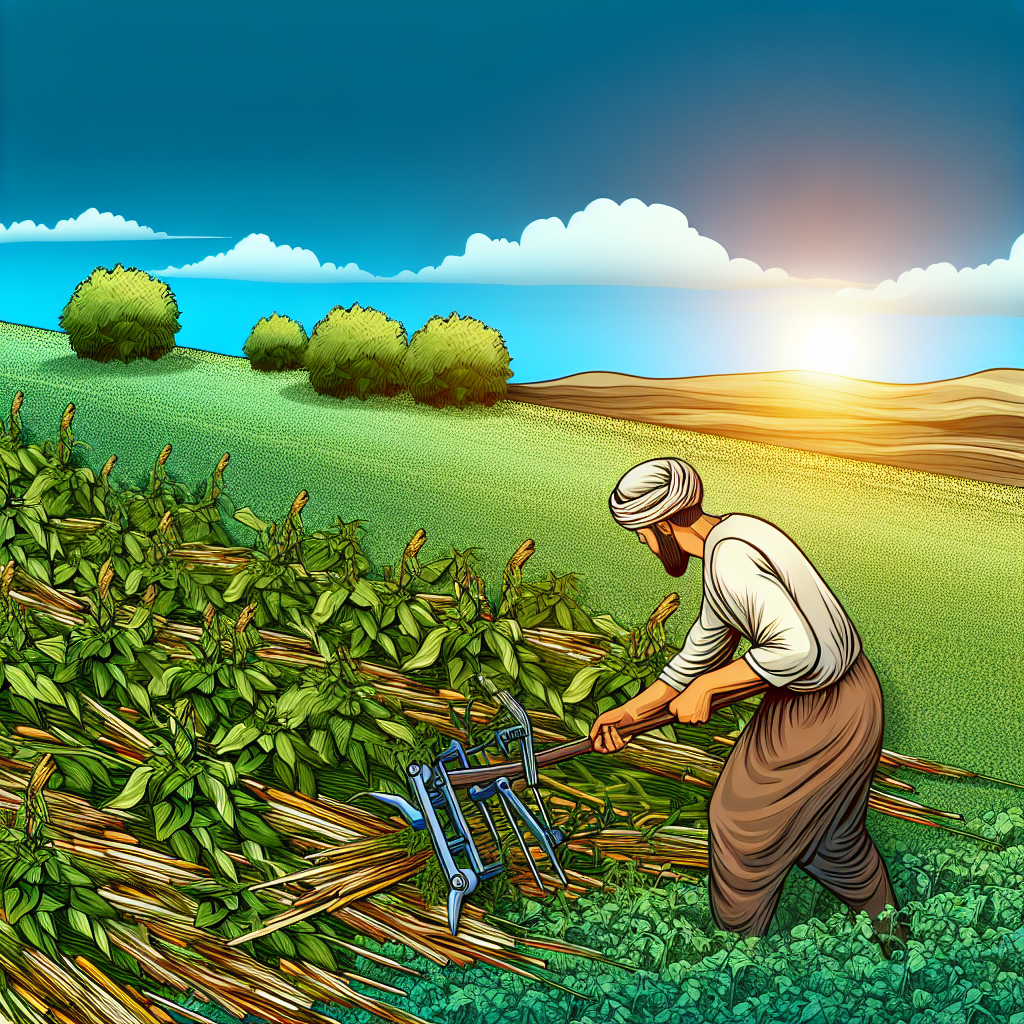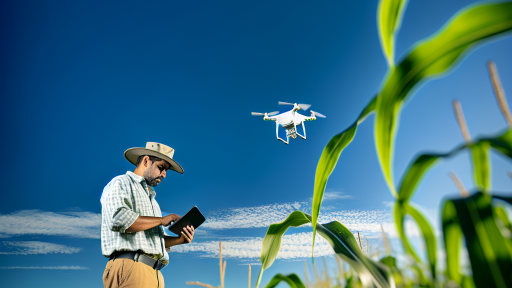Introduction to Cover Crop Termination
Importance of Cover Crop Termination
Cover crop termination is crucial for agricultural success.
It influences soil health and nutrient cycling.
Moreover, it impacts subsequent crop performance.
Effective termination prevents competition for resources.
Additionally, it allows farmers to manage residue effectively.
Consequently, understanding the timing is vital.
Objectives of Cover Crop Termination
The primary objective is to optimize soil health.
Healthy soil promotes better crop yields.
Another goal is to improve weed management.
This practice can suppress weed growth significantly.
Furthermore, it aims to enhance moisture conservation.
Retaining soil moisture supports crop establishment.
Benefits of Proper Termination Timing
Proper timing maximizes cover crop benefits.
It allows organic matter to decompose adequately.
Well-timed termination increases soil nutrient availability.
Transform Your Agribusiness
Unlock your farm's potential with expert advice tailored to your needs. Get actionable steps that drive real results.
Get StartedThis practice can also improve soil structure.
Improved structure enhances root growth for crops.
Consequently, it leads to disease suppression.
Challenges in Cover Crop Termination
Termination can pose challenges for farmers.
Weather conditions often affect timing options.
Additionally, equipment limitations can create complications.
Farmers must also consider crop rotations.
These factors may influence termination methods.
Thus, careful planning is essential for success.
Mechanical Termination Methods: Tools and Techniques
Understanding Mechanical Termination
Mechanical termination involves physically cutting or uprooting cover crops.
This method provides immediate results in terminating unwanted vegetation.
Farmers can choose from various tools to achieve effective termination.
Common Tools for Mechanical Termination
Several tools are available for mechanical termination of cover crops.
- Rotary Mowers
- Flail Mowers
- Disc Mowers
- Brush Cutters
- Front-End Loaders
Each tool has unique features suited for different crop types.
Techniques for Effective Termination
Using the right technique maximizes the effectiveness of mechanical termination.
Timing is crucial when terminating cover crops mechanically.
Targeting the crops at flowering stage enhances effectiveness.
Mowing
Mowing is among the most common methods used in termination.
It can be performed at different heights based on the crop.
Lower cuts stimulate quicker decay and rapid breakdown of biomass.
Chopping
Chopping involves using specialized equipment to cut the crops into smaller pieces.
This method promotes faster decomposition and integrates easily into the soil.
Maintenance of Equipment
Proper maintenance extends the life of termination tools.
Cleaning blades after use prevents rust buildup and ensures efficiency.
Showcase Your Farming Business
Publish your professional farming services profile on our blog for a one-time fee of $200 and reach a dedicated audience of farmers and agribusiness owners.
Publish Your ProfileRegular inspections enhance performance and safety during operation.
Considerations for Selecting Methods
When choosing termination methods, consider the crop type and conditions.
Weather factors and soil moisture levels significantly impact effectiveness.
Evaluate equipment availability and operational costs beforehand.
Chemical Termination Methods
Application Guidelines
Understanding chemical termination is essential for effective crop management.
Farmers can utilize specific herbicides for cover crop termination.
Select the right timing for application to maximize effectiveness.
It’s crucial to apply herbicides when cover crops are in peak growth.
Observe the manufacturer’s guidelines for dosage and application techniques.
Consider weather conditions when timing your applications.
Windy days can lead to drift, impacting neighboring crops.
Rain forecasts soon after application can wash away herbicides.
Therefore, check the weather patterns before application.
Best Practices for Application
Adhere to best practices for safety and effectiveness.
Always wear appropriate personal protective equipment, or PPE.
Set up sprayers to ensure even distribution of the chemical.
Check nozzle sizes and types to match the specific herbicide.
Calibrate your sprayer prior to application to ensure accuracy.
Additionally, control the speed of the application for even coverage.
After application, monitor the area for any signs of crop stress.
Evaluate the termination results to refine future applications.
Precautions to Consider
Be aware of potential environmental impacts of chemical termination.
Avoid runoff into nearby water sources by following guidelines.
Understand the herbicide’s residual effects on future crops.
Consider crop rotation impacts when selecting herbicides.
Document your application methods for future reference.
Consult with extension services for localized guidance.
You Might Also Like: Choosing the Right Hydroponic Setup
Natural Methods of Termination: Grazing and Smother Cropping
Utilizing Grazing for Termination
Grazing is a valuable method to terminate cover crops effectively.
Livestock such as sheep and goats can efficiently consume cover crops.
This method reduces the need for mechanical termination.
Additionally, grazing provides natural fertilization through manure.
It promotes soil health while controlling unwanted weeds.
Farmers can manage grazing patterns to avoid overgrazing.
Furthermore, timing is crucial for optimal results.
Implementing Smother Cropping
Smother cropping involves planting fast-growing species to choke out cover crops.
This method effectively reduces competition for sunlight and nutrients.
Common smother crops include buckwheat and mustard.
These crops can suppress weeds and enhance soil organic matter.
They create a thick layer that inhibits weed seed germination.
Showcase Your Farming Business
Publish your professional farming services profile on our blog for a one-time fee of $200 and reach a dedicated audience of farmers and agribusiness owners.
Publish Your ProfileMoreover, smother crops can improve soil structure over time.
Successful implementation requires careful timing and management.
Learn More: How to Boost Soil Fertility Naturally on Farms
Timing Considerations
Understanding the Importance of Timing
Timing plays a critical role in cover crop termination.
Proper timing impacts soil health and crop yield positively.
Moreover, it influences pest management and nutrient cycling.
Factors Affecting Timing
Several factors determine the ideal termination time for cover crops.
- Crop growth stage is essential for effective termination.
- Weather conditions can accelerate or delay termination.
- Soil moisture levels affect how quickly crops break down.
Optimal Termination Periods
Generally, the best termination occurs before planting cash crops.
In the Midwest, this typically happens in early spring.
Specifically, aim for termination two to three weeks before planting.
Signs of Readiness for Termination
Look for specific signs to determine when to terminate cover crops.
- Cover crops should be in the flowering stage.
- Plants should show early signs of senescence.
- Check for sufficient biomass accumulation for soil benefits.
Consequences of Poor Timing
Failing to terminate cover crops at the right time can lead to problems.
Overgrown cover crops may compete with cash crops for nutrients.
Additionally, delayed termination can hinder planting schedules.
Delve into the Subject: Integrating AI Solutions In Crop Analytics

Evaluating Soil Health: The Role of Termination Methods on Soil Quality
Understanding Soil Health
Soybean health is crucial for sustainable agriculture.
It affects crop productivity and ecosystem functionality.
A healthy soil promotes beneficial microbial activity.
Additionally, it improves nutrient cycling and water retention.
Impact of Cover Crops on Soil Health
Cover crops enhance soil structure and reduce erosion.
They can improve organic matter content significantly.
These crops also suppress weeds and manage pests naturally.
Moreover, they contribute to carbon sequestration in the soil.
Importance of Termination Methods
Terminating cover crops affects soil health outcomes.
Different methods yield varied impacts on soil quality.
Appropriately chosen termination methods maximize benefits.
Common Termination Methods
- Mechanical termination includes tillage or mowing.
- Chemical termination uses herbicides for effective control.
- Weed suppression is achieved through smothering techniques.
Evaluating Termination Methods
Evaluation involves assessing the impact on soil structure.
Soil texture changes can indicate the success of methods.
Farmers should monitor microbial activity post-termination.
Also, soil organic matter levels provide insight into health.
Selecting the Best Method
Choosing effective methods depends on crop rotation plans.
Environmental conditions also influence this decision.
Ultimately, farmers should align methods with their goals.
Analyzing past experiences helps refine future practices.
Delve into the Subject: Crop Protection Strategies Through Disease Forecasting
Case Studies: Successful Termination Methods from Different Regions
Midwestern USA: No-Till Termination
In the Midwest, farmers utilize no-till methods for terminating cover crops.
This method minimizes soil disturbance and conserves moisture levels.
For instance, Sarah Thompson from Illinois achieves significant results.
She reports improved soil health and increased yield using this approach.
Southeastern USA: Herbicide Applications
Farmers in the Southeast often rely on herbicide applications for cover crop termination.
Showcase Your Farming Business
Publish your professional farming services profile on our blog for a one-time fee of $200 and reach a dedicated audience of farmers and agribusiness owners.
Publish Your ProfileJeffrey Reynolds, a farmer in Georgia, favors this method for its efficiency.
He applies glyphosate to effectively kill the cover crops before planting.
With this technique, he avoids weed competition during the growing season.
Western USA: Flame Weeding
In the western regions, flame weeding is gaining traction among farmers.
Mary Johnson in California demonstrates the effectiveness of this method.
She uses a handheld propane torch to terminate cover crops quickly.
This method helps manage pests without introducing chemicals into the soil.
International Case: France’s Mulching Technique
In France, farmers use mulching as a prominent termination method.
Jean-Pierre Dupont, a French farmer, highlights its benefits for soil health.
He rolls down cut cover crops, creating a natural mulch layer.
This technique improves moisture retention and suppresses weed growth.
Comparative Analysis of Methods
Each termination method reflects regional needs and conditions.
No-till is ideal for preserving soil structure in the Midwest.
Herbicide application presents efficiency advantages in the Southeast.
Flame weeding offers a chemical-free option in the West.
Mulching demonstrates ecological benefits for farmers in Europe.
Best Practices Across Regions
Successful farmers adapt their methods based on local environments.
They also consider crop types and expected weather patterns.
Communication among farmers enhances the sharing of effective practices.
Additionally, experimental approaches pave the way for innovative solutions.
Future Trends in Cover Crop Termination
Innovative Termination Techniques
Researchers are developing new methods to terminate cover crops effectively.
These methods focus on minimizing soil disturbance.
Moreover, they aim to enhance nutrient release for subsequent crops.
For example, advancements in roller-crimper technology show promise.
These tools allow for effective termination while leaving crop residue intact.
Consequently, soil health is improved through increased organic matter.
Precision Agriculture Integration
Precision agriculture is transforming cover crop management.
Farmers now use data analytics to determine optimal termination timing.
This approach maximizes benefits while minimizing costs.
Additionally, drone technology allows for precise monitoring of cover crops.
With aerial imagery, farmers can assess crop health and growth stages.
This data supports informed decision-making for termination strategies.
Research Directions for Sustainable Practices
Future research will explore the ecological impacts of cover crop termination.
Studies will assess effects on soil biodiversity and water retention.
Researchers will also investigate various species of cover crops.
Understanding which species perform best in specific conditions is crucial.
Furthermore, the role of cover crops in carbon sequestration will be examined.
This knowledge will inform guidelines for sustainable agriculture practices.
Collaboration Across Sectors
Collaboration between farmers and researchers is vital.
Such partnerships can drive innovations in termination methods.
Showcase Your Farming Business
Publish your professional farming services profile on our blog for a one-time fee of $200 and reach a dedicated audience of farmers and agribusiness owners.
Publish Your ProfileSharing best practices across communities will enhance overall success.
Moreover, agricultural extension services can provide valuable education.
Workshops on updated techniques and technologies will foster adoption.
This collective effort can lead to better crop management outcomes.
Additional Resources
Cereal rye cover crop termination at or before soybean planting has …
Can Cover Cropping Heal Abused Soil? A Mad Farm Reflection …




